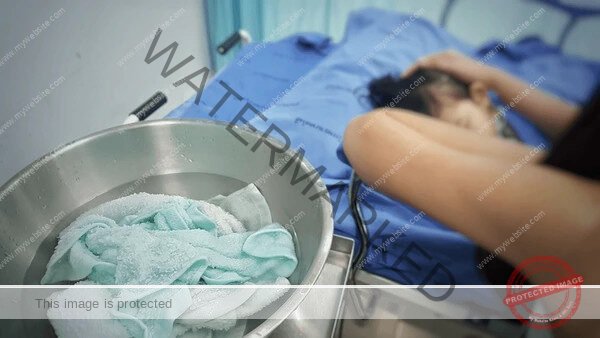Foundations of Nursing I
Subtopic:
Tepid sponging

Tepid sponging is a nursing procedure involving the application of lukewarm water (generally 29°C to 32°C) to the skin surface using a sponge or soft cloth in order to reduce elevated body temperature (fever) through evaporative and conductive heat loss mechanisms. This non-pharmacologic method of antipyresis is often employed in conjunction with or prior to the administration of antipyretic medications.
Purpose of Tepid Sponging
To promote reduction of pyrexia (fever) in febrile patients
To provide comfort and prevent febrile seizures, especially in pediatric cases
To stimulate vasodilation, thereby enhancing peripheral circulation
To support the body’s homeostatic mechanisms when fever becomes detrimental
To supplement pharmacologic treatment where medication alone is insufficient or contraindicated
Indications
Tepid sponging is indicated in the following situations:
Persistent hyperthermia (typically ≥38.5°C) not responding promptly to antipyretics
Febrile convulsions or history of convulsions, especially in children
Drug allergy or contraindications to antipyretics
Situations where physical cooling is preferred over pharmacologic methods
Supportive care in infectious diseases associated with high fever (e.g., malaria, dengue, typhoid)
Contraindications
The procedure is not suitable in the following conditions:
Chilling or shivering, which may paradoxically increase body temperature
In patients with hypothermia, subnormal temperature, or shock
Neonates, unless directed by pediatric guidelines
Patients with cardiac conditions where rapid temperature changes could induce stress
In cases where skin conditions (e.g., burns, dermatitis) may be aggravated by water application
Physiological Basis
Tepid sponging reduces temperature through the principles of:
Evaporation: Heat is absorbed from the body surface to convert water into vapor, thereby cooling the skin.
Conduction: Direct heat transfer occurs from the warmer body to the cooler sponge or cloth.
Vasodilation: Tepid water promotes peripheral blood vessel dilation, improving heat dissipation from the body core to the surface.
The hypothalamic thermoregulatory center monitors internal body temperature and adjusts responses. Tepid sponging supports these mechanisms when endogenous control is overwhelmed or compromised.
Materials Required
Basin with tepid water (29°C–32°C; verify using thermometer)
Two small towels or soft sponges
Bath towel or sheet for privacy
Waterproof sheet to protect the bed
Thermometer (preferably digital)
Gloves (optional but recommended for infection control)
Patient gown (clean and dry)
Waste disposal bag
Preparation Phase
1. Patient Assessment:
Confirm presence of fever and its degree via thermometer.
Assess skin integrity, sensory response, and any contraindications.
Review medical records for underlying causes and treatment plans.
2. Environment Preparation:
Ensure privacy by drawing curtains or closing the door.
Keep the room at a comfortable ambient temperature (~25°C).
Avoid direct exposure to drafts or fans during sponging.
3. Explain Procedure:
Inform the patient about the purpose and what to expect.
Address any fears of discomfort or cold sensations.
Procedure
Hand hygiene is performed and gloves worn.
The patient is placed in supine or semi-Fowler’s position, ensuring comfort and access to exposed skin areas.
The water temperature is verified as tepid (not cold) using a thermometer or inner wrist.
A waterproof sheet is placed under the patient’s body to protect the bedding.
The face, neck, and arms are sponged first using gentle strokes.
Proceed to chest, abdomen, back, and then lower limbs, following a head-to-toe sequence.
The axillae and groin areas may be targeted to enhance cooling, as they are rich in blood vessels.
Avoid prolonged wetness by gently patting the skin dry with a towel.
Observe for shivering, discomfort, or changes in consciousness.
Once complete, dress the patient in a clean, dry gown and ensure the bed linen is dry and warm.
Measure temperature again after 30 minutes and evaluate effectiveness.
Post-Procedural Care
Monitor temperature, pulse, and respiratory rate at 15–30 minute intervals.
Assess for chills, pallor, or discomfort.
Document:
Initial and post-sponging temperature
Duration and areas covered
Patient’s tolerance and skin condition
Any adverse reactions
Reinforce hydration if permissible, as fever may cause fluid loss.
Precautions and Safety Measures
Never use cold water or ice as this can induce vasoconstriction, shivering, and paradoxical temperature elevation.
Discontinue sponging if the patient exhibits shivering, hypotension, or increased distress.
Always maintain dignity and privacy throughout the procedure.
Maintain infection control protocols, especially in patients with contagious illnesses.
Refrain from sponging open wounds or inflamed skin areas.
Avoid excessive exposure time; the procedure generally lasts 15 to 20 minutes.
Potential Complications
Shivering and discomfort if water is too cold or the room is inadequately warm
Inadequate temperature reduction if evaporation is hampered
Skin irritation in sensitive patients
Hypothermia if not properly monitored
Psychological distress due to perceived vulnerability or exposure
Related Topics
General Principles and Rules of All Nursing Procedures
• Hospital Economy
• Use of Personal Protective Equipment
• Routine and Weekly Cleaning of the Ward
• Waste Management and Disposal
• Isolation of Infectious Patients
• Causes of Infection
• Medical Waste Disposal and Management
• Cleaning Methods
• Carry out Adequate Feeding of Patients
• Perform Bladder and Bowel Care
• Passing a Flatus Tube
• Administration of Enema
• Ward Report
• Lifting/Positioning a Patient
• Tepid Sponging
• General Principles in Patient Care
• Ethics in Nursing Care
• Principles of Infection Prevention and Control
• Body Mechanics
• Bed Making
• Vital Observations
• Bed Bath
• Oral Care/Mouth Care
• Care and Treatment of Pressure Ulcers
Get in Touch
(+256) 790 036 252
(+256) 748 324 644
Info@nursesonlinediscussion.com
Kampala ,Uganda
© 2025 Nurses online discussion. All Rights Reserved Design & Developed by Opensigma.co

